Daily News
by Gail Helmer
[ Send Us News | Archives ]
Electronic Arts has released a new group of screenshots from its upcoming World War II action game, Medal of Honor: Allied Assault. The new exclusive screens show off Mission One, the Normandy Campaign.
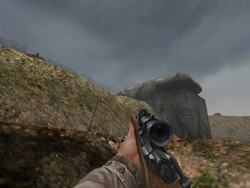
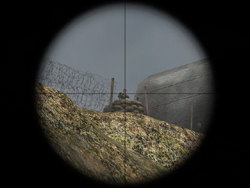
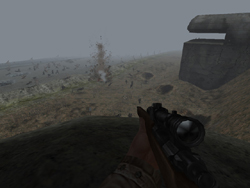
In the game, players will assume the role of an Allied soldier, and they will take on a number of difficult assignments behind enemy lines in a variety of locations, including France, North Africa, and Norway. The first-person shooter is powered by the Quake III engine, and it will feature a complete single-player campaign along with deathmatch and capture-the-flag multiplayer modes.
MechCommander 2 Goes Gold
Microsoft today announced that MechCommander 2 has gone gold and will be in stores on July 19. In the game, players guide roving squads of enormous BattleMechs in real-time combat. MechCommander 2 features full 3D terrain that provides tactical advantages for sensors, probes, and scouts. Also available will be camera controls that can view the action from high above or up-close and personal. People will even be able to create their own missions using the same tools as the MechCommander 2 level designers.
Starfleet Command: Orion Pirates Ships
Interplay Entertainment announced today that the latest addition to the Star Trek: Starfleet Command franchise, Star Trek: Starfleet Command - Orion Pirates has shipped to retail. Starfleet Command - Orion Pirates is a stand-alone mission pack that adds a new storyline and significant new features to the Star Trek: Starfleet Command series and will allow gamers the unique experience of playing as the ruthless Orion Pirates for the first time.
Developed by Taldren, Starfleet Command - Orion Pirates centers on the deadly Orion Pirates, a popular, long-standing element of the Star Trek universe. A brutal force of privateers and criminals controlling territories of Federation space, the Orion Pirates consist of eight cartels, each with unique histories, user interfaces, crew voices and identifying logos. The game features a 12-mission campaign plus 26 skirmish missions and three bonus missions based on the classic TV episode "A Piece of the Action."
In these bonus missions, players must return to the Planet Iotia to execute a deal negotiated by the Starship Enterprise, collecting dues from 1920's style gangsters. Instead, they find that the Orions have been hard at work muscling in on the Iotians, carving up that part of the galaxy. This latest installment of the Starfleet Command series features new phaser types, including shield piercing, along with other new weapons such as heavy photons.
Aces High Screenshots Wanted
HiTech Creations is looking for screenshots from their MMOG Aces High to put on their webpage. If you have some nice screenshots that you would like to see up on their webpage, visit their screenshot forum. Click here
General Dynamics Armament Systems, a business unit of General Dynamics (NYSE: GD), has been awarded a $12.5 million, firm-fixed price contract by the U.S. Army, Tank-Automotive Command in Rock Island, Ill., for production of 832 MK19 40mm grenade machine guns. The three-year contract includes options for an additional 2,496 guns with a maximum order value of $49 million. The MK19s will be produced at the General Dynamics facility in Saco, Maine.
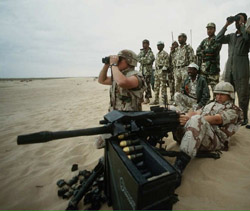
General Dynamics has produced more than 25,000 MK19 systems for the U.S. Government since 1986. Firing M430 High Explosive Dual Purpose (HEDP) grenades, the MK19 enhances the normal infantry firepower, which consists of rifles, mortars and crew-served machine guns, by providing lethal firepower. American Ordnance, a General Dynamics Armament Systems joint venture, produces the M430 round for the MK19 at the Milan Army Ammunition Plant in Milan, Tennessee.(US Marine Corps Photo)
Lockheed Martin Begins S-3 Viking Testing
Lockheed Martin Aeronautics Company yesterday began full scale fatigue testing (FSFT) of a U.S. Navy S-3 Viking anti-submarine warfare (ASW) aircraft at its facility here. "This marks an important milestone in the S-3 program," Mark Jarvis, the S-3 program's manager, said. "The future of the U.S. Navy S-3 community hinges upon the data generated by these fatigue tests."
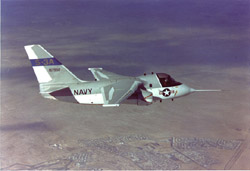
The S-3 Viking has been and continues to be the backbone of the U.S. Navy's ASW fleet and one of the key components of the U.S. Navy's worldwide maritime dominance. Originally built at Lockheed Martin's Burbank, Calif., facility, the S-3 has been in naval service since the 1970s.
The S-3 is currently certified for a structural life of 13,000 hours, which the Viking fleet is rapidly approaching. The S-3 FSFT program will determine how much longer the Navy could keep their Vikings flying.
"The U.S. Navy and the Defense Department have chosen to extend the operational service of this much honored aircraft, and it is up to the Lockheed Martin/Navy Integrated Product Team to determine by how much that service can be extended," Jarvis said. "Their decision to continue operational use of the S-3 Viking will provide the Navy with extended and unmatched ASW capability for years to come."
The U.S. Government, with data provided by LM Aeronautics' FSFT program, hopes to certify the S-3's operational life through 17,750 flight hours through these fatigue tests. Lockheed Martin has been prepping an S-3 fatigue test article since winning the Navy's $40 million contract for this work in 1998. The fatigue testing -- which encompasses "bending and flexing" the aircraft to determine the physical limitations of the components and materials from which it is made -- should conclude in late 2002.
Metal Storm Gun for UCAVs and Robotic Vehicles
Metal Storm Limited has completed a US government-funded study into potential defence applications of its 100% electronic ballistics technology. The feasibility study examined the use of the technology in electronically operated gun pods for Tactical Mobile Robotic Vehicles (TMRVs) and Unmanned Combat Aerial Vehicles (UCAVs).
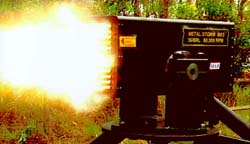
The completed study is one of a number currently underway as an extension of the A$17 million Defense Advanced Research Projects Agency (DARPA) programme awarded to Metal Storm in March 2000 to develop a prototype Advanced Sniper Rifle for US defence forces.
The report from the A$660,000 study has now been submitted to DARPA, the managing agency for the Advanced Sniper Rifle project.
Metal Storm's Managing Director, Mike O'Dwyer, said that one of the scenarios explored in the study was a situation where an Unmanned Combat Aerial Vehicle (UCAV) armed with a Metal Storm gun pod could provide active protection for surveillance aircraft, such as the Joint Surveillance Target Attack Radar System (JSTARS) or other high-value aerial assets. JSTARS systems are carried aboard long-range surveillance aircraft, designed to locate, classify and track ground targets in all weather conditions, day or night. JSTARS gives allied commanders the information necessary to make effective decisions by providing real-time situational awareness.
Mike O'Dwyer said the study also examined the potential to incorporate Metal Storm technology on ground-based robotic vehicles. In one scenario a robotic vehicle equipped with a Metal Storm system, fires a dense array of kinetic projectiles or explosive shells in a pattern, which opens an entry through a block or concrete wall. The advantage of robotic vehicles is that they can be sent in ahead of troops to force an entry. Operating the robotic system achieves the objective remotely, while minimising danger to troops.
Mr. O'Dwyer said the company is hopeful that during the coming months the study will lead to additional US Government research funding to develop these additional applications of the revolutionary Metal Storm technology to fully operational prototypes.
US DoD Amended Budget For FY 2002
Secretary of Defense Donald Rumsfeld has released details of President Bush's Fiscal Year (FY) 2002 amended defence budget. The amended budget adds funding and programme details to the broad defence vision the President outlined in February in his budget submission to Congress, 'A Blueprint for New Beginnings'.
Secretary Rumsfeld said the new budget begins an increased focus on future threats. "If we are to extend this period of peace and prosperity, we need to prepare now for the new and different threats we will face in the decades ahead and not wait until they fully emerge." He said the new budget balances preparation for the future with current needs -- through robust funding to improve morale, boost readiness, transform defence capabilities, and upgrade ageing facilities.
The amended budget requests $328.9 billion in discretionary budget authority for the Department of Defense (DoD). The proposed new topline is $18.4 billion more than Blueprint DoD total of $310.5 billion. It is $32.6 billion higher than the $296.3 billion enacted by Congress for FY 2001 - an inflation-adjusted increase of 7 percent. The $32.6 billion topline increase in FY 2002 is in addition to the President's $6 billion FY 2001 supplemental appropriations request, nearly all of which is for defence activities related to military quality of life and readiness.
Secretary Rumsfeld stressed that it begins to address selected shortfalls in readiness, healthcare, operations, maintenance, infrastructure. Besides addressing shortfalls, the budget supports modernisation programmes consistent with the early results of the Secretary's ongoing strategy review.
Reflecting the large increases in pay and allowances, funding for Military Personnel is to climb from $75 billion in FY 2001 to $82 billion in FY 2002. The budget includes the President's $1.4 billion Blueprint initiative for military compensation. It funds a targeted pay raise - at least 5 percent for every service member and up to 10 percent for enlisted grades E-4 to E-9 and for mid-grade officers. The budget includes $17.9 billion for the Defence Health Programme - up from $12.1 billion in FY 2001.
The FY 2002 amended budget will boost readiness, which has been strained by a high tempo of operations and escalating maintenance costs for ageing equipment. Readiness is funded primarily in Operation and Maintenance (O&M) accounts, funding for which will climb from $108 billion in FY 2001 to $126 billion in FY 2002.
The budget includes funding for the Military Services' readiness requirements -- for flying hours, ship operations, training, weapon system maintenance and repair, base operations, spare parts, force protection, utilities, and training range repair and support.
The budget makes a major investment toward reducing the backlog of weapon system maintenance (e.g., Air Force aircraft maintenance funding will increase to the 92 percent level and Navy ship maintenance funding will increase to 90 percent).
FY 2002 funding includes:
The budget includes $61.6 billion for Procurement. It aligns programmes and funding to provide balanced and strong support for both the US military's short-term requirements and for its long-term transformation.
The budget aligns Research, Development, Test, and Evaluation (RDT&E) funding and programmes to target technologies with the greatest promise for transforming the US defence posture. Within RDT&E, the budget includes $8.8 billion for Science and Technology (S&T), which funds basic and applied research and development of technologies and prototype subsystems - all of which are key to preserving America's superiority in military capabilities.
The budget includes a total of $7.0 billion for Ballistic Missile Defence Organisation (BMDO) programmes and $1.3 billion for lower tier systems that will be devolved to the Services. It emphasises a new approach focused on an expanded, robust RDT&E programme with flexibility to pursue most promising developments. The Airborne Laser, Space-Based Laser, and Space-Based InfraRed System (SBIRS) Low programmes are to be merged into the BMDO program.
The budget funds design studies to convert two TRIDENT submarines to cruise missile carrying submarines and by beginning to retire Peacekeeper missiles. It also boosts funding for programmes that the ongoing strategy review has identified as especially critical to countering threats that appear likely in the future, e.g., close-in ship self-defence improvements, E-2C radar modernisation, chemical/biological vaccines, and miniature munitions.
[ Send Us News | Archives ]
by Gail Helmer
Thursday, June 28, 2001
- New Allied Assault Screens
- MechCommander 2 Goes Gold
- Starfleet Command: Orion Pirates Ships
- Aces High Screenshots Wanted
- General Dynamics Awarded MK19 Gun Contract
- Lockheed Martin Begins S-3 Viking Testing
- Metal Storm Gun for UCAVs and Robotic Vehicles
- US DoD Amended Budget For FY 2002
- Jane's News Briefs
PC News
New Allied Assault ScreensElectronic Arts has released a new group of screenshots from its upcoming World War II action game, Medal of Honor: Allied Assault. The new exclusive screens show off Mission One, the Normandy Campaign.



In the game, players will assume the role of an Allied soldier, and they will take on a number of difficult assignments behind enemy lines in a variety of locations, including France, North Africa, and Norway. The first-person shooter is powered by the Quake III engine, and it will feature a complete single-player campaign along with deathmatch and capture-the-flag multiplayer modes.
MechCommander 2 Goes Gold
Microsoft today announced that MechCommander 2 has gone gold and will be in stores on July 19. In the game, players guide roving squads of enormous BattleMechs in real-time combat. MechCommander 2 features full 3D terrain that provides tactical advantages for sensors, probes, and scouts. Also available will be camera controls that can view the action from high above or up-close and personal. People will even be able to create their own missions using the same tools as the MechCommander 2 level designers.
Starfleet Command: Orion Pirates Ships
Interplay Entertainment announced today that the latest addition to the Star Trek: Starfleet Command franchise, Star Trek: Starfleet Command - Orion Pirates has shipped to retail. Starfleet Command - Orion Pirates is a stand-alone mission pack that adds a new storyline and significant new features to the Star Trek: Starfleet Command series and will allow gamers the unique experience of playing as the ruthless Orion Pirates for the first time.
Developed by Taldren, Starfleet Command - Orion Pirates centers on the deadly Orion Pirates, a popular, long-standing element of the Star Trek universe. A brutal force of privateers and criminals controlling territories of Federation space, the Orion Pirates consist of eight cartels, each with unique histories, user interfaces, crew voices and identifying logos. The game features a 12-mission campaign plus 26 skirmish missions and three bonus missions based on the classic TV episode "A Piece of the Action."
In these bonus missions, players must return to the Planet Iotia to execute a deal negotiated by the Starship Enterprise, collecting dues from 1920's style gangsters. Instead, they find that the Orions have been hard at work muscling in on the Iotians, carving up that part of the galaxy. This latest installment of the Starfleet Command series features new phaser types, including shield piercing, along with other new weapons such as heavy photons.
Aces High Screenshots Wanted
HiTech Creations is looking for screenshots from their MMOG Aces High to put on their webpage. If you have some nice screenshots that you would like to see up on their webpage, visit their screenshot forum. Click here
Military News
General Dynamics Awarded MK19 Gun ContractGeneral Dynamics Armament Systems, a business unit of General Dynamics (NYSE: GD), has been awarded a $12.5 million, firm-fixed price contract by the U.S. Army, Tank-Automotive Command in Rock Island, Ill., for production of 832 MK19 40mm grenade machine guns. The three-year contract includes options for an additional 2,496 guns with a maximum order value of $49 million. The MK19s will be produced at the General Dynamics facility in Saco, Maine.

General Dynamics has produced more than 25,000 MK19 systems for the U.S. Government since 1986. Firing M430 High Explosive Dual Purpose (HEDP) grenades, the MK19 enhances the normal infantry firepower, which consists of rifles, mortars and crew-served machine guns, by providing lethal firepower. American Ordnance, a General Dynamics Armament Systems joint venture, produces the M430 round for the MK19 at the Milan Army Ammunition Plant in Milan, Tennessee.(US Marine Corps Photo)
Lockheed Martin Begins S-3 Viking Testing
Lockheed Martin Aeronautics Company yesterday began full scale fatigue testing (FSFT) of a U.S. Navy S-3 Viking anti-submarine warfare (ASW) aircraft at its facility here. "This marks an important milestone in the S-3 program," Mark Jarvis, the S-3 program's manager, said. "The future of the U.S. Navy S-3 community hinges upon the data generated by these fatigue tests."

The S-3 Viking has been and continues to be the backbone of the U.S. Navy's ASW fleet and one of the key components of the U.S. Navy's worldwide maritime dominance. Originally built at Lockheed Martin's Burbank, Calif., facility, the S-3 has been in naval service since the 1970s.
The S-3 is currently certified for a structural life of 13,000 hours, which the Viking fleet is rapidly approaching. The S-3 FSFT program will determine how much longer the Navy could keep their Vikings flying.
"The U.S. Navy and the Defense Department have chosen to extend the operational service of this much honored aircraft, and it is up to the Lockheed Martin/Navy Integrated Product Team to determine by how much that service can be extended," Jarvis said. "Their decision to continue operational use of the S-3 Viking will provide the Navy with extended and unmatched ASW capability for years to come."
The U.S. Government, with data provided by LM Aeronautics' FSFT program, hopes to certify the S-3's operational life through 17,750 flight hours through these fatigue tests. Lockheed Martin has been prepping an S-3 fatigue test article since winning the Navy's $40 million contract for this work in 1998. The fatigue testing -- which encompasses "bending and flexing" the aircraft to determine the physical limitations of the components and materials from which it is made -- should conclude in late 2002.
Metal Storm Gun for UCAVs and Robotic Vehicles
Metal Storm Limited has completed a US government-funded study into potential defence applications of its 100% electronic ballistics technology. The feasibility study examined the use of the technology in electronically operated gun pods for Tactical Mobile Robotic Vehicles (TMRVs) and Unmanned Combat Aerial Vehicles (UCAVs).

The completed study is one of a number currently underway as an extension of the A$17 million Defense Advanced Research Projects Agency (DARPA) programme awarded to Metal Storm in March 2000 to develop a prototype Advanced Sniper Rifle for US defence forces.
The report from the A$660,000 study has now been submitted to DARPA, the managing agency for the Advanced Sniper Rifle project.
Metal Storm's Managing Director, Mike O'Dwyer, said that one of the scenarios explored in the study was a situation where an Unmanned Combat Aerial Vehicle (UCAV) armed with a Metal Storm gun pod could provide active protection for surveillance aircraft, such as the Joint Surveillance Target Attack Radar System (JSTARS) or other high-value aerial assets. JSTARS systems are carried aboard long-range surveillance aircraft, designed to locate, classify and track ground targets in all weather conditions, day or night. JSTARS gives allied commanders the information necessary to make effective decisions by providing real-time situational awareness.
Mike O'Dwyer said the study also examined the potential to incorporate Metal Storm technology on ground-based robotic vehicles. In one scenario a robotic vehicle equipped with a Metal Storm system, fires a dense array of kinetic projectiles or explosive shells in a pattern, which opens an entry through a block or concrete wall. The advantage of robotic vehicles is that they can be sent in ahead of troops to force an entry. Operating the robotic system achieves the objective remotely, while minimising danger to troops.
Mr. O'Dwyer said the company is hopeful that during the coming months the study will lead to additional US Government research funding to develop these additional applications of the revolutionary Metal Storm technology to fully operational prototypes.
US DoD Amended Budget For FY 2002
Secretary of Defense Donald Rumsfeld has released details of President Bush's Fiscal Year (FY) 2002 amended defence budget. The amended budget adds funding and programme details to the broad defence vision the President outlined in February in his budget submission to Congress, 'A Blueprint for New Beginnings'.
Secretary Rumsfeld said the new budget begins an increased focus on future threats. "If we are to extend this period of peace and prosperity, we need to prepare now for the new and different threats we will face in the decades ahead and not wait until they fully emerge." He said the new budget balances preparation for the future with current needs -- through robust funding to improve morale, boost readiness, transform defence capabilities, and upgrade ageing facilities.
The amended budget requests $328.9 billion in discretionary budget authority for the Department of Defense (DoD). The proposed new topline is $18.4 billion more than Blueprint DoD total of $310.5 billion. It is $32.6 billion higher than the $296.3 billion enacted by Congress for FY 2001 - an inflation-adjusted increase of 7 percent. The $32.6 billion topline increase in FY 2002 is in addition to the President's $6 billion FY 2001 supplemental appropriations request, nearly all of which is for defence activities related to military quality of life and readiness.
Secretary Rumsfeld stressed that it begins to address selected shortfalls in readiness, healthcare, operations, maintenance, infrastructure. Besides addressing shortfalls, the budget supports modernisation programmes consistent with the early results of the Secretary's ongoing strategy review.
Reflecting the large increases in pay and allowances, funding for Military Personnel is to climb from $75 billion in FY 2001 to $82 billion in FY 2002. The budget includes the President's $1.4 billion Blueprint initiative for military compensation. It funds a targeted pay raise - at least 5 percent for every service member and up to 10 percent for enlisted grades E-4 to E-9 and for mid-grade officers. The budget includes $17.9 billion for the Defence Health Programme - up from $12.1 billion in FY 2001.
The FY 2002 amended budget will boost readiness, which has been strained by a high tempo of operations and escalating maintenance costs for ageing equipment. Readiness is funded primarily in Operation and Maintenance (O&M) accounts, funding for which will climb from $108 billion in FY 2001 to $126 billion in FY 2002.
The budget includes funding for the Military Services' readiness requirements -- for flying hours, ship operations, training, weapon system maintenance and repair, base operations, spare parts, force protection, utilities, and training range repair and support.
The budget makes a major investment toward reducing the backlog of weapon system maintenance (e.g., Air Force aircraft maintenance funding will increase to the 92 percent level and Navy ship maintenance funding will increase to 90 percent).
FY 2002 funding includes:
- Aircraft Operations/Flying hours: $11.5 billion (up from $9.3 billion in FY 2001)
- Army OPTEMPO: $2.7 billion (same as $2.7 billion in FY 2001)
- Ship operations: $2.9 billion (up from $2.8 billion in FY 2001)
- Depot maintenance: $9.3 billion (up from $7.7 billion in FY 2001)
- Training $9.3 billion (up from $8.5 billion in FY 2001)
- Facility/Base support $20.7 billion (up from $17.9 billion in FY 2001)
The budget includes $61.6 billion for Procurement. It aligns programmes and funding to provide balanced and strong support for both the US military's short-term requirements and for its long-term transformation.
The budget aligns Research, Development, Test, and Evaluation (RDT&E) funding and programmes to target technologies with the greatest promise for transforming the US defence posture. Within RDT&E, the budget includes $8.8 billion for Science and Technology (S&T), which funds basic and applied research and development of technologies and prototype subsystems - all of which are key to preserving America's superiority in military capabilities.
The budget includes a total of $7.0 billion for Ballistic Missile Defence Organisation (BMDO) programmes and $1.3 billion for lower tier systems that will be devolved to the Services. It emphasises a new approach focused on an expanded, robust RDT&E programme with flexibility to pursue most promising developments. The Airborne Laser, Space-Based Laser, and Space-Based InfraRed System (SBIRS) Low programmes are to be merged into the BMDO program.
The budget funds design studies to convert two TRIDENT submarines to cruise missile carrying submarines and by beginning to retire Peacekeeper missiles. It also boosts funding for programmes that the ongoing strategy review has identified as especially critical to countering threats that appear likely in the future, e.g., close-in ship self-defence improvements, E-2C radar modernisation, chemical/biological vaccines, and miniature munitions.
